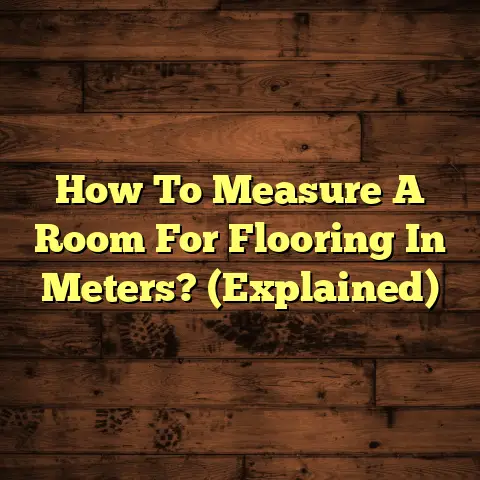Adjust Laminate Planks? (3 Easy Hacks!)
I’m here to spill the beans on
keeping your laminate floors looking
sharp.
One of the significant
advantages of adjusting laminate
planks correctly is the enhanced
longevity and aesthetic appeal of
your flooring.
When your planks are properly aligned, not only does it provide a seamless look, but it also prevents future issues such as warping, buckling, or gaps that can compromise the integrity of your floor.
I’ve seen firsthand how a little
TLC can save you big bucks down the
road.
This article will guide you
through three easy hacks to adjust
your laminate planks effectively,
ensuring your flooring remains
beautiful and durable for years to
come.
Let’s get started!
Section 1: Understanding the Basics
of Laminate Flooring
So, what exactly is laminate
flooring?
It’s basically a
multi-layer synthetic flooring
product fused together with a
lamination process.
Think of it
as a high-tech, super-durable
photo of wood (or stone, or tile!)
bonded to a sturdy core.
Here’s a quick rundown of the components:
-
Wear Layer: The top layer, protecting against scratches, stains, and fading.
-
Decorative Layer: This is where the magic happens – the realistic image of wood, stone, etc.
-
Core Board: Usually made of high-density fiberboard (HDF) or medium-density fiberboard (MDF), providing stability and impact resistance.
-
Backing Layer: The bottom layer, providing balance and protection against moisture.
Now, even with its durability,
laminate isn’t immune to problems.
What are some common issues that
may arise with laminate planks?
I’m talking about gaps, buckling,
and uneven surfaces.
Gaps can appear between planks,
buckling is when the floor rises
up, and uneven surfaces can make
your floor feel… well, uneven!
These issues can stem from a few
different sources.
Environmental factors play a huge role:
Humidity: Laminate can expand in high humidity and contract in low humidity.
This movement can cause gaps or buckling.
According to the EPA, maintaining a humidity level between 30-50% is ideal for indoor environments.
(Source: https://www.epa.gov/)-
Temperature: Extreme temperature fluctuations can also affect laminate.
-
Improper Installation: Leaving insufficient expansion gaps during installation is a major culprit.
-
Subfloor Issues: An uneven or unstable subfloor can cause laminate planks to shift and become uneven.
I’ve seen cases where a sudden
heatwave caused a perfectly good
laminate floor to buckle overnight!
Understanding these factors is the
first step in keeping your laminate
looking its best.
Section 2: Hack #1 – The Power of
the Floor Gap Fixer
Alright, let’s dive into our first
hack!
Ever heard of a floor gap
fixer?
It’s a nifty tool designed
to gently nudge those pesky gaps
between laminate planks back
together.
Think of it as a
miniature car jack for your floor!
How does it work?
The floor gap fixer typically
consists of a lever or ratcheting
mechanism attached to a padded
block.
You position the block
against the plank you want to move,
and then use the lever to apply
pressure, gradually closing the gap.
Here’s a step-by-step guide on how to use one:
-
Gather Your Tools:
- Floor gap fixer tool
- Hammer (preferably a rubber mallet)
- Protective gear (gloves, knee pads)
- Soft cloth or wood block (to protect the plank edge)
Identify the Gaps: Take a good look at your floor and pinpoint the areas where gaps have formed.
Sometimes they’re obvious, but other times you might need to get down on your hands and knees for a closer inspection.Position the Gap Fixer: Place the padded block of the gap fixer against the edge of the plank you want to move.
Make sure it’s making solid contact.Apply Pressure: Slowly and steadily, begin applying pressure using the lever or ratcheting mechanism of the gap fixer.
You should see the plank gradually moving towards its neighbor.Tap Gently (If Needed): If the plank is stubborn, you can use a hammer and a soft cloth or wood block to gently tap the edge of the plank while applying pressure with the gap fixer.
This helps to encourage movement.Repeat as Necessary: Continue this process until the gap is closed.
You may need to reposition the gap fixer and repeat the steps several times to achieve the desired result.Inspect Your Work: Once the gap is closed, take a step back and inspect your work.
Make sure the planks are flush and even.
Tips for Success:
Don’t Overdo It: Apply pressure gradually.
Forcing the plank too quickly can damage the tongue-and-groove system.-
Protect the Edges: Always use a soft cloth or wood block when tapping with a hammer to prevent chipping or denting the plank edges.
Work with the Room: Consider the overall layout of the room.
Sometimes, closing a gap in one area might create a small gap in another.
When is this hack needed?
I remember one time, a client had
a huge gap near their doorway
because they kept bumping it with
their vacuum cleaner.
The floor gap
fixer worked like a charm!
Section 3: Hack #2 – Using Spacers
for Proper Expansion Gaps
Expansion gaps are the unsung
heroes of laminate flooring!
These
small spaces, typically around
1/4 to 3/8 of an inch, are left
around the perimeter of the room
during installation to allow the
laminate to expand and contract
with changes in humidity and
temperature.
Without these gaps, the laminate
would have nowhere to go, leading
to buckling and other problems.
I
cannot stress this enough!
Here’s how to use spacers to adjust planks and maintain proper expansion gaps:
-
Gather Your Materials:
- Spacers (you can buy these specifically for flooring, or use small pieces of wood or plastic)
- Measuring tape
- Level
Identify Areas with Insufficient Gaps: Walk around the perimeter of your room and look for areas where the laminate is tight against the wall or baseboard.
These are the areas where you need to create or adjust the expansion gap.Measure the Existing Gap: Use your measuring tape to measure the width of the existing gap.
If it’s less than 1/4 inch, you need to create more space.Place the Spacers: Insert the spacers between the laminate planks and the wall or baseboard.
Space them evenly around the perimeter of the room, typically every 12-18 inches.-
Check for Level: Use your level to ensure that the laminate planks are level and not being pushed up or down by the spacers.
Make Adjustments (If Needed): If the planks are not level, you may need to adjust the placement or size of the spacers.
You can also use a rubber mallet to gently tap the planks into place.
Common Mistakes to Avoid:
-
Using Spacers That Are Too Thick: This can create an excessively large gap that looks unattractive.
Forgetting to Remove Spacers After Installation: This is a classic mistake!
Always remove the spacers after the adhesive or locking system has had time to set.-
Ignoring Uneven Walls: If your walls are not perfectly straight, you may need to use different sized spacers to maintain a consistent expansion gap.
I had a client who insisted on
installing their laminate flooring
themselves.
They skipped the
spacers entirely, and within a few
months, the entire floor buckled!
It was a costly lesson for them.
Section 4: Hack #3 – The Heat Gun
Method for Warped Planks
Warped laminate planks can be a
real eyesore.
Temperature changes,
especially in areas with high
humidity, can cause the laminate
to expand unevenly, leading to
warping.
But don’t despair!
The
heat gun method can often help to
flatten those warped planks.
Here’s how it works:
The heat from the heat gun softens
the laminate, allowing it to become
more pliable.
By applying gentle
pressure while heating, you can
encourage the plank to return to
its original shape.
Important Safety Note: This
method requires caution.
Overheating
the laminate can cause damage, so
it’s crucial to monitor the
temperature and work slowly.
Here’s a step-by-step guide:
-
Gather Your Materials:
- Heat gun
- Soft cloth
- Protective gloves
- Weight (e.g., a heavy book or sandbag)
Prepare the Area: Clean the warped plank and the surrounding area.
Make sure the area is dry.Apply Heat: Set your heat gun to a low setting.
Hold the nozzle about 6-8 inches away from the warped plank and move it slowly and evenly across the surface.
Avoid concentrating the heat in one spot.Soften the Laminate: Continue applying heat until the laminate feels slightly soft and pliable.
This usually takes a few minutes.Apply Pressure: Place the soft cloth over the heated area and then place the weight on top of the cloth.
This will help to flatten the plank as it cools.Allow to Cool: Let the plank cool completely with the weight in place.
This may take several hours.Remove Weight and Inspect: Once the plank is cool, remove the weight and the cloth.
Inspect the plank to see if it has flattened.
If necessary, repeat the process.
Tips for Success:
-
Start with a Low Heat Setting: It’s always better to start with a lower temperature and gradually increase it if needed.
Keep the Heat Gun Moving: Never hold the heat gun in one spot for too long.
This can cause the laminate to scorch or bubble.-
Use a Soft Cloth: This will protect the laminate from scratches and prevent the weight from leaving marks.
Monitoring the Temperature:
It’s crucial to monitor the
temperature of the laminate while
using the heat gun.
You don’t want
to overheat it and cause damage.
If you’re unsure, it’s always best
to err on the side of caution and
use a lower heat setting.
I once tried to rush this process
and ended up with a slightly
melted spot on a client’s floor.
Luckily, it was in an inconspicuous
area, but it taught me a valuable
lesson about patience!
Section 5: Maintenance Tips for
Long-Lasting Laminate Flooring
Prevention is always better than
cure!
Here are some practical
maintenance tips that can help
prevent issues with your laminate
planks in the future:
Regular Cleaning: Sweep or vacuum your laminate floor regularly to remove dirt and debris.
Use a damp mop (not soaking wet!) with a laminate- specific cleaner.Humidity Control: Maintain a consistent humidity level in your home, ideally between 30- 50%.
Use a humidifier or dehumidifier as needed.Protect Against Scratches: Use felt pads under furniture legs to prevent scratches.
Avoid wearing shoes with sharp heels on the laminate floor.-
Avoid Standing Water: Wipe up spills immediately to prevent water from seeping into the seams between planks.
Periodic Inspections: Regularly inspect your laminate floor for any signs of problems, such as gaps, buckling, or uneven surfaces.
Address these issues promptly to prevent them from worsening.
According to the National Wood
Flooring Association (NWFA),
proper maintenance can significantly
extend the life of your laminate
flooring.
(Source:
https://www.nwfa.org/)
I always tell my clients that a little bit of regular maintenance can save them a lot of headaches (and money!) down the road.
Conclusion
So there you have it – three easy
hacks to adjust your laminate
planks and keep your floors looking
their best!
We covered everything
from using a floor gap fixer to
taming warped planks with a heat
gun.
Remember, adjusting laminate planks
properly is crucial for maintaining
the flooring’s beauty and
longevity.
By implementing these
hacks and following the maintenance
tips, you can ensure that your
laminate floors will look great for
years to come.
Now, go forth and conquer those
flooring woes!
And if you ever
need a helping hand, you know who
to call.
Happy flooring!





